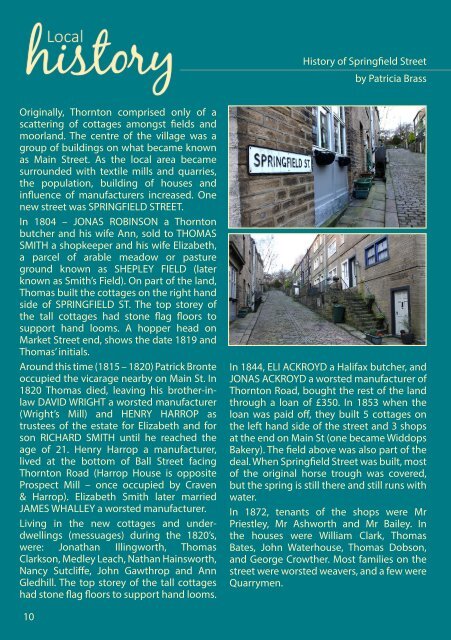Dear Reader
Thornton-Directory-FEBRUARY-2016-Online-version
Thornton-Directory-FEBRUARY-2016-Online-version
Create successful ePaper yourself
Turn your PDF publications into a flip-book with our unique Google optimized e-Paper software.
History of Springfield Street<br />
by Patricia Brass<br />
Originally, Thornton comprised only of a<br />
scattering of cottages amongst fields and<br />
moorland. The centre of the village was a<br />
group of buildings on what became known<br />
as Main Street. As the local area became<br />
surrounded with textile mills and quarries,<br />
the population, building of houses and<br />
influence of manufacturers increased. One<br />
new street was SPRINGFIELD STREET.<br />
In 1804 – JONAS ROBINSON a Thornton<br />
butcher and his wife Ann, sold to THOMAS<br />
SMITH a shopkeeper and his wife Elizabeth,<br />
a parcel of arable meadow or pasture<br />
ground known as SHEPLEY FIELD (later<br />
known as Smith’s Field). On part of the land,<br />
Thomas built the cottages on the right hand<br />
side of SPRINGFIELD ST. The top storey of<br />
the tall cottages had stone flag floors to<br />
support hand looms. A hopper head on<br />
Market Street end, shows the date 1819 and<br />
Thomas’ initials.<br />
Around this time (1815 – 1820) Patrick Bronte<br />
occupied the vicarage nearby on Main St. In<br />
1820 Thomas died, leaving his brother-inlaw<br />
DAVID WRIGHT a worsted manufacturer<br />
(Wright’s Mill) and HENRY HARROP as<br />
trustees of the estate for Elizabeth and for<br />
son RICHARD SMITH until he reached the<br />
age of 21. Henry Harrop a manufacturer,<br />
lived at the bottom of Ball Street facing<br />
Thornton Road (Harrop House is opposite<br />
Prospect Mill – once occupied by Craven<br />
& Harrop). Elizabeth Smith later married<br />
JAMES WHALLEY a worsted manufacturer.<br />
Living in the new cottages and underdwellings<br />
(messuages) during the 1820’s,<br />
were: Jonathan Illingworth, Thomas<br />
Clarkson, Medley Leach, Nathan Hainsworth,<br />
Nancy Sutcliffe, John Gawthrop and Ann<br />
Gledhill. The top storey of the tall cottages<br />
had stone flag floors to support hand looms.<br />
In 1844, ELI ACKROYD a Halifax butcher, and<br />
JONAS ACKROYD a worsted manufacturer of<br />
Thornton Road, bought the rest of the land<br />
through a loan of £350. In 1853 when the<br />
loan was paid off, they built 5 cottages on<br />
the left hand side of the street and 3 shops<br />
at the end on Main St (one became Widdops<br />
Bakery). The field above was also part of the<br />
deal. When Springfield Street was built, most<br />
of the original horse trough was covered,<br />
but the spring is still there and still runs with<br />
water.<br />
In 1872, tenants of the shops were Mr<br />
Priestley, Mr Ashworth and Mr Bailey. In<br />
the houses were William Clark, Thomas<br />
Bates, John Waterhouse, Thomas Dobson,<br />
and George Crowther. Most families on the<br />
street were worsted weavers, and a few were<br />
Quarrymen.<br />
10


